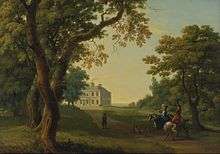William Ashford
| William Ashford | |
|---|---|
 William Ashford by William Cuming | |
| Born |
1746 Birmingham, England |
| Died | 17 April 1824 (aged 77–78) |
| Known for | landscape painting |
William Ashford (1746 - 1824) was an English landscape painter who worked exclusively in Ireland.[1][2]
Life
Ashford was born in Birmingham, England in 1746, baptised 20 May 1746 in St Martin's parish church. He was the son of Richard Ashford. Little is known about his education, but it is presumed he received some technical or artistic training in England.[2] He moved to Dublin, Ireland, in 1764 at the age of eighteen after having obtained an appointment in the Ordnance Office through the interest of the Surveyor-General, Ralph Ward.[3] His job, at least in the early years, consisted of checking on the armaments stored at forts and barracks across Ireland.[4]
Ashford married circa 1775, the name of his wife is unknown. The couple had two sons and one daughter. His son, Daniel, became an artist but did not receive the same acclaim as his father. The architect, James Gandon, designed his home in Sandymount, County Dublin in 1792 where he lived for the rest of his life.[2]
Career

Within three years of his arrival, Ashford was exhibiting with the Society of Artists on William Street. At first, he was an amateur painter specialising in flower paintings and still life, but in 1772 he exhibited his first landscape at the Dublin Royal Society of Arts. He turned professional soon after.[1][5] After the death of Thomas Roberts, Ashford became the pre-eminent landscaper in Ireland.[2]
He was elected President of the Irish Society of Artists in 1813, was a founding member of the Royal Hibernian Academy, becoming its first elected President in 1823.[6]
He also exhibited in England, at The Royal Academy in London from 1775 and with the Society of Artists from 1777. Despite becoming a fellow of the Society the next year, Ashford only exhibited there sporadically, works shown there including a set of views of North Wales. From 1806 he showed at the newly-established British Institution. Some of his pieces seen there had been painted some years earlier, including some subject pictures showing scenes from Shakespeare.[1] Ashford lived at a number of addresses in Dublin and London, travelling back and forth exhibiting as his career progressed.[2]
Ashford was among the most respected landscape painters of Ireland in his time, on par with Thomas Roberts and George Barret. Most of his works were topographical views of country seats and well-ordered parks and his principal patrons were, therefore, the nobility and landowners. Institutions such as Society of Artists in Ireland, the Academy of Artists in Dublin, and the Cork Society for Promoting Fine Arts exhibited his work. He was most prolific from 1777–1813, selling numerous paintings at auction.[2]
At the beginning of the 19th century – probably between 1804 and 1806[4] – he painted a set of landscapes in and around Mount Merrion for Lord Fitzwilliam. It was near this time that he completed his Marino Casino, one of his finest works.[7] The Fitzwilliam commission was the last major one he received, although he continued to paint, and held an exhibition of his works in the board room of the Dublin Society's premises in 1819.[4] In the last decade of his life he painted less, with his last known painting dated as 1821.[2]
Ashford's work is viewed as heavily influenced by painters such as Claude Lorraine and Richard Wilson, especially in his use of a warm continental palette. Artists like James Arthur O'Connor show Ashford's influence in the Irish landscape painting genre.[2] As well as his landscape painting, Ashford is also known for his flower paintings, with his early work painted in the Dutch style.[8]

Later life and recognition
Ashford died 17 April 1824 at his home.[1] Some of his work is held in the National Gallery of Ireland and the Fitzwilliam Museum, Cambridge.[8][9]
In January 2008, three paintings by Ashford were donated to the Irish Heritage Trust by a Cork business family, the McCarthys.[10]
References
- 1 2 3 4 Crookshank, Anne (2004). "Ashford, William (1746–1824)". Oxford Dictionary of National Biography. Oxford University Press.
- 1 2 3 4 5 6 7 8 Beaumont, Daniel (2009). "Ashford, William". In McGuire, James; Quinn, James. Dictionary of Irish Biography. Cambridge: Cambridge University Press.
- ↑ Ashford, William, P.R.H.A. (b. 1746, d. 1824), Landscape Painter, From: A Dictionary of Irish Artists, 1913
- 1 2 3 Crookshank, Ann (1995). "A Life Devoted To Landscape Painting: William Ashford". Irish Arts Review Yearbook. 11.
- ↑ "William Ashford". The Berger Collection. Archived from the original on 7 January 2005. Retrieved 11 July 2008.
- ↑ William Ashford at Whyte's: Biographies or Irish Art and Irish Artists. Retrieved 22 March 2008.
- ↑ Arnold, Bruce. A Concise History of Irish Art. Thames and Hudson, London. 1969. pp. 91–92. Retrieved 21 April 2008.
- 1 2 Butler, Patricia (2000). Irish Botanical Illustrators & Flower Painters. Suffolk: Antique Collectors' Club. p. 60-61.
- ↑ Butler, Patricia (1997). Three Hundred Years of Irish Watercolours. London: Phoenix Illustrated. p. 35-36.
- ↑ "Historic paintings donated to Fota". The Irish Times. 21 January 2008. Retrieved 19 October 2016.
External links
| Wikimedia Commons has media related to William Ashford. |
- Webb, Alfred (1878). "
 Ashford, William". A Compendium of Irish Biography. Dublin: M. H. Gill & son. Wikisource
Ashford, William". A Compendium of Irish Biography. Dublin: M. H. Gill & son. Wikisource - William Ashford (Encyclopedia of Irish and World Art)
- View of Killarney with the passage to the upper lake (1778 painting)
- The Casino at Marino, Dublin (1776 painting)
- Landscape with Carriage and Horses (c. 1781 painting).